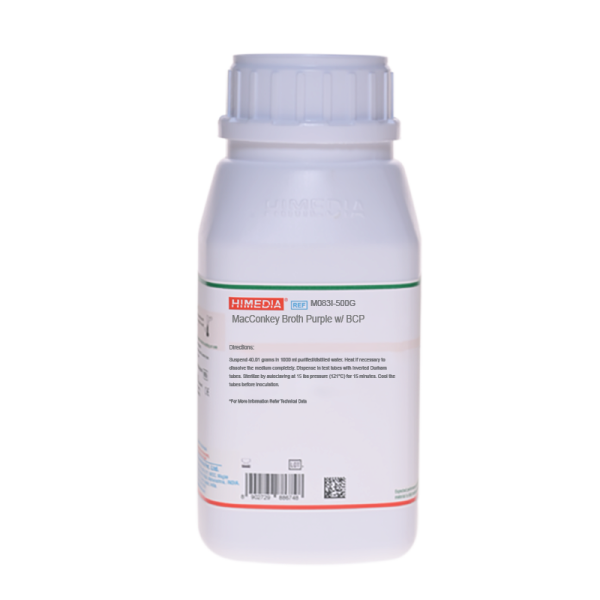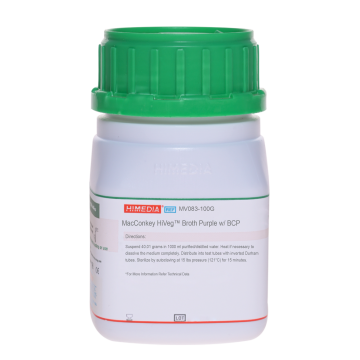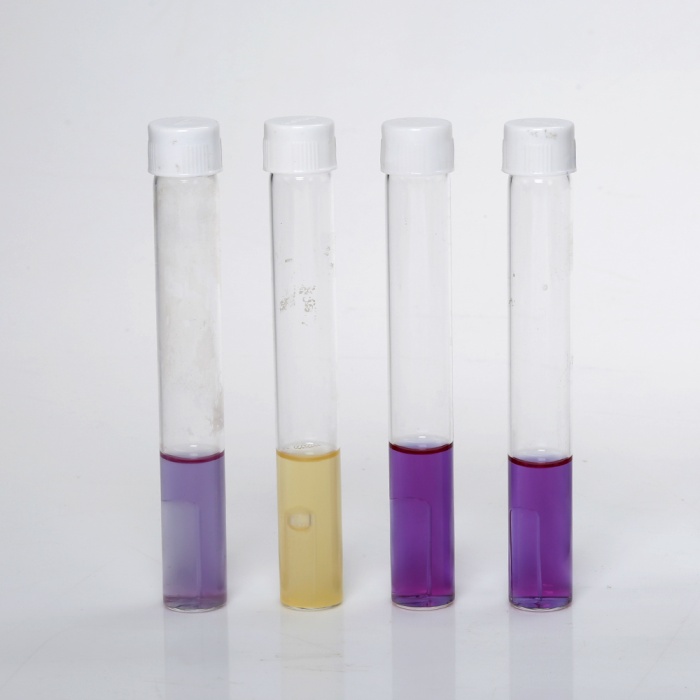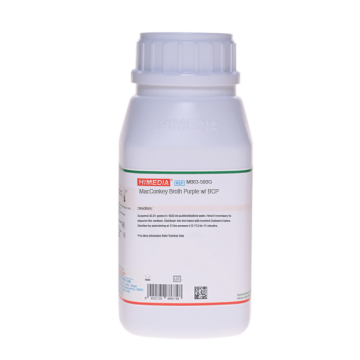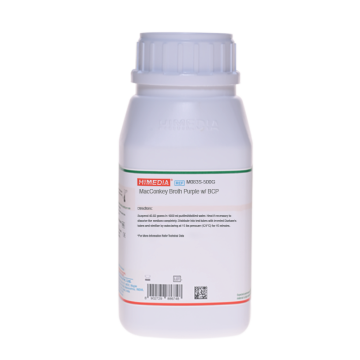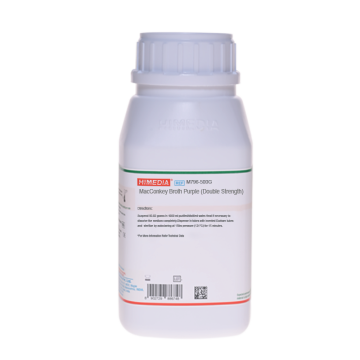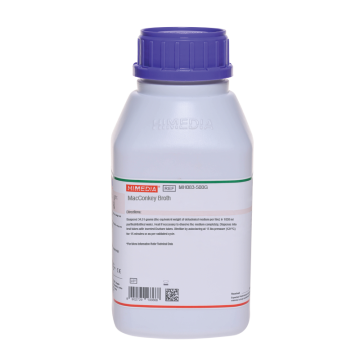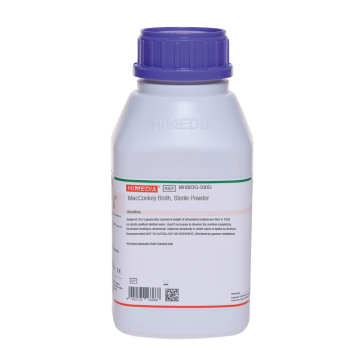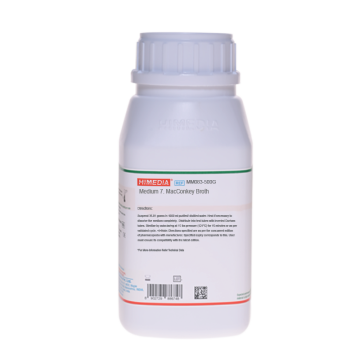 Your enquiry has been submitted
Your enquiry has been submitted
MacConkey Broth Purple w/ BCP
Intended Use
Recommended for presumptive identification of coliforms from water. The composition and performance criteria of this medium are as per the specifications laid down in ISO 9308-2:2012 & ISO 4832:2006.
Composition**
| Ingredients | Gms / Litre |
|---|---|
| Peptone | 20.000 |
| Lactose | 10.000 |
| Bile salts | 5.000 |
| Sodium chloride | 5.000 |
| Bromocresol purple | 0.010 |
Final pH (at 25°C): 7.4±0.2
**Formula adjusted, standardized to suit performance parameters
Directions
Suspend 40.01 grams in 1000 ml purified / distilled water. Heat if necessary to dissolve the medium completely. Dispense into test tubes with inverted Durham tubes. Sterilize by autoclaving at 15 lbs pressure (121°C) for 15 minutes. Cool the tubes to 45-50°C before inoculation.
Principle And Interpretation
MacConkey Broth Purple w/ BCP is a modification of MacConkey Medium (6). Childs and Allen (2) demonstrated the inhibitory effect of neutral red and therefore substituted it by the less inhibitory bromocresol purple dye. BCP is more sensitive in recording pH variation in the medium. MacConkey Broth Purple w/ BCP is recommended by ISO committee (3) with the inclusion of bile salts, as a presumptive test medium for identification of coliforms from water and other materials of sanitary importance.
Peptone provides essential growth nutrients. Lactose is the fermentable carbohydrate. Bile salts or sodium taurocholate inhibits gram-positive organisms. Sodium chloride maintains the osmotic balance of the medium. Bromocresol purple is the pH indicator in the medium, which turns yellow under acidic condition. Lactose fermenting organisms turn the medium yellow due to the acidity produced on lactose fermentation. The colour change of the dye is observed when the pH of the medium falls below 6.8. Lactose non-fermenting organisms like Salmonella and Shigella do not alter the appearance of the medium. Liquid specimens are directly inoculated while solids have to be homogenized in appropriate diluents such as physiological saline, phosphate buffers, etc. If the inoculum is greater than 1 ml, it is necessary to use the medium at double strength, inoculating equal volumes of specimen and medium.
Type of specimen
Water samples
Specimen Collection and Handling:
For water samples, follow appropriate techniques for sample collection, processing as per guidelines and local standards.(1) After use, contaminated materials must be sterilized by autoclaving before discarding.
Warning and Precautions :
Read the label before opening the container. Wear protective gloves/protective clothing/eye protection/ face protection. Follow good microbiological lab practices while handling specimens and culture. Standard precautions as per established guidelines should be followed while handling specimens. Safety guidelines may be referred in individual safety data sheets.
Limitations :
- Liquid specimens are directly inoculated while solids have to be homogenized in appropriate diluents such as physiological saline, phosphate buffers, etc.
- If the inoculum is greater than 1 ml, it is necessary to use the medium at double strength, inoculating equal volumes of specimen and medium.
Performance and Evaluation
Performance of the medium is expected when used as per the direction on the label within the expiry period when stored at recommended temperature.
Quality Control
Appearance: Cream to yellow homogeneous free flowing powder
Colour and Clarity of prepared medium: Purple coloured clear to slightly opalescent solution in tubes
Reaction: Reaction of 3.45% w/v aqueous solution at 25°C.pH:-7.4±0.2
pH: 7.20-7.60
Cultural Response
Growth Promotion is carried out in accordance with the harmonized method of IP. For organisms not specified in pharmacopoeia, cultural response was observed after an incubation at 30-35°C for 18-48 hours.
Growth promoting properties
Clearly visible growth of microorganism comparable to that previously obtained with previously tested and approved lot of medium occurs at the specified temperature for not more than the shortest period of time specified inoculating <=100 cfu (at 42-44°C for 24 hours).
Inhibitory properties
No growth of the test microorganism occurs for the specified temperature for not less than longest period of time specified inoculating >=100cfu(at 42-44°C for >= 48 hours).
| Organism | Inoculum (CFU) | Growth | Acid | Gas | Incubation temperature | Incubation period |
|---|---|---|---|---|---|---|
| Escherichia coli ATCC 8739 (00012*) | 50-100 | luxuriant | positive reaction, yellow colour | positive reaction | 42-44 °C | <=24 hrs |
| Inhibitory | ||||||
| Staphylococcus aureus subsp. aureus ATCC 6538 (00032*) | >=104 | inhibited | 42-44 °C | >=48 hrs | ||
| Additional Microbiological testing | ||||||
| Escherichia coli ATCC 25922 (00013*) | 50-100 | luxuriant | positive reaction, yellow colour | positive reaction | 30-35 °C | 18-24 hrs |
| Escherichia coli NCTC 9002 | 50-100 | luxuriant | positive reaction, yellow colour | positive reaction | 30-35 °C | 18-24 hrs |
| # Klebsiella aerogenes ATCC 13048 (00175*) | 50-100 | luxuriant | positive reaction, yellow colour | positive reaction | 30-35 °C | 18-24 hrs |
| Salmonella Choleraesuis ATCC 12011 | 50-100 | fair-good | negative reaction | negative reaction | 30-35 °C | 18-24 hrs |
| Staphylococcus aureus subsp. aureus ATCC 25923 (00034*) | >=104 | inhibited | 30-35 °C | >=48 hrs | ||
Key: *Corresponding WDCM numbers. # Formerly known as Enterobacter aerogenes
Please refer disclaimer Overleaf.
Storage and Shelf Life
Store between 10-30°C in a tightly closed container and the prepared medium at 15-25°C. Use before expiry date on the label. On opening, product should be properly stored dry, after tightly capping the bottle in order to prevent lump formation due to the hygroscopic nature of the product. Improper storage of the product may lead to lump formation. Store in dry ventilated area protected from extremes of temperature and sources of ignition. Seal the container tightly after use.
Product performance is best if used within stated expiry period.
Disposal
User must ensure safe disposal by autoclaving and/or incineration of used or unusable preparations of this product. Follow established laboratory procedures in disposing of infectious materials and material that comes into contact with sample must be decontaminated and disposed of in accordance with current laboratory techniques (4,5).
Reference
- Baird R.B., Eaton A.D., and Rice E.W., (Eds.), 2015, Standard Methods for the Examination of Water and Wastewater, 23rd ed., APHA, Washington, D.C.
- Childs E. and Allen, 1953, J. Hyg: Camb. 51:468-477.
- International Organization for Standardization (ISO), 1990, Draft ISO/ DIS 9308-2.
- Isenberg, H.D. Clinical Microbiology Procedures Handbook 2nd Edition.
- Jorgensen, J.H., Pfaller, M.A., Carroll, K.C., Funke, G., Landry, M.L., Richter, S.S and Warnock., D.W. (2015) Manual of Clinical Microbiology, 11th Edition. Vol. 1.
- MacConkey A. T., 1900, The Lancet, ii: 20.
| Product Name | MacConkey Broth Purple w/ BCP |
|---|---|
| SKU | M083I |
| Product Type | Regular |
| Physical Form | Powder |
| Origin | Animal |
| Packaging type | HDPE |
| References | 1. MacConkey A. T., 1900, The Lancet, ii: 20. 2.Childs E. and Allen, 1953, J. Hyg: Camb. 51:468-477 3.Baird R.B., Eaton A.D., and Rice E.W., (Eds.), 2015, Standard Methods for the Examination of Water andWastewater, 23rd ed., APHA, Washington, D.C. 4.Isenberg, H.D. Clinical Microbiology Procedures Handbook. 2nd Edition. 5.Jorgensen,J.H., Pfaller , M.A., Carroll, K.C., Funke, G., Landry, M.L., Richter, S.S and Warnock., D.W. (2015)Manual of Clinical Microbiology, 11th Edition. Vol. 1. 6.American Public Health Association, Standard Methods for the Examination of Dairy Products, 1978, 14th Ed., WashingtonD.C. 7.Salfinger Y., and Tortorello M.L. Fifth (Ed.), 2015, Compendium of Methods for the Microbiological Examination ofFoods, 5th Ed., American Public Health Association, Washington, D.C. 8.Wehr H. M. and Frank J. H., 2004, Standard Methods for the Microbiological Examination of Dairy Products, 17th Ed.,APHA Inc., Washington, D.C. |
| Customized Product Available | No |



